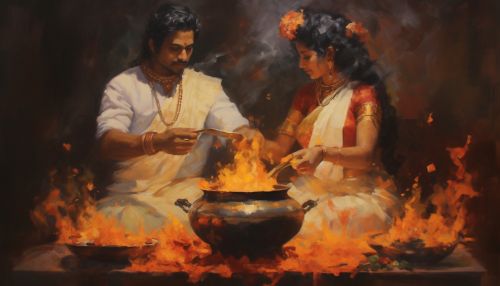Agni
Introduction
Agni is a principal deity in Hinduism, one of the most ancient religions in the world. He is the god of fire and the acceptor of sacrifices. The word Agni is Sanskrit for "fire" (noun), and the related adjective Agneya means "of fire". In the Vedic literature, Agni is a major and oft-invoked god along with Indra and Soma. Agni is considered the mouth of the gods and goddesses, and the medium that conveys offerings to them in a homa (ritual fire). He is conceptualized in ancient Hindu texts to exist at three levels, on earth as fire, in the atmosphere as lightning, and in the sky as the sun. This triple presence connects him as the messenger between gods and human beings in the Vedic thought.


Etymology and other names
The etymology of Agni is uncertain and contested. Significant proposals include from either root ag (to move, go, migrate) or root aj (to drive, hurl, cause to move). Some scholars suggest that the word Agni has been borrowed from Indo-Iranian Agni already attested in the Zoroastrianism scriptures of ancient Iran, while others state that it is a natural evolution of word, with the Proto-Indo-European root h₁n̥gʷnis (fire) evolving into angni in the Proto-Indo-Iranian era, and then to Agni in the Sanskrit era.
Agni has many names in Hindu scriptures. He is called the son of Angiras and the son of Kasyapa, as well as variously as Apām Napāt, Jātavedas, Tanūnapāt, Shuchi, Vaishvānara, Atharvan, Mātariśvan, and Hiranyaretas.
Characteristics and Iconography
In the Vedic and post-Vedic texts of Hinduism, Agni is depicted in various ways - an adorable god, a supreme god, a guest, a witness, a protector, a hero well disposed, a sage, a priest, a king, and a lord of rites. He is the divine priest who leads and is the symbol of the rites-deity, and it is through Agni that the gods are invoked and the offerings reach them. He is the one who leads and is the symbol of the rites-deity, and it is through Agni that the gods are invoked and the offerings reach them.
In art and literature, Agni is depicted with two or seven hands, two heads, and three legs. He has countenance and hair that are bright and luminous, reflecting his symbolic association with light and illumination. He is shown with a long beard, suggesting his ancient origins, a feature that is unique to Agni and no other Hindu god. He is usually depicted with a rosary in his right hand, a staff in his left hand, and a pot of ghee. His vehicle is the ram or the rooster, reflecting his solar associations.
Role in Rituals
Agni plays a central role in the Vedic rituals, as well as the wedding and household rituals of Hindus. During a Hindu wedding, the presence of Agni as the divine witness is a requisite, and the couple takes seven steps around the Agni during the wedding ceremony. Agni is also a part of other Hindu rites, such as the naming of a child, the rites of passage during a person's life, and the cremation of the dead.
In the Vedic literature, Agni is the one who conveys the offerings of humans to the gods. He is also the one who brings the gods to the rituals, and the intermediary between humans and gods. He is the one who measures the offering and pours it into the mouth of the gods.
Agni in Hindu Scriptures
Agni is a significant deity in the Rigveda, the oldest of the Vedas. He is mentioned more than 200 times in the Rigveda, and his role and importance grow over time. In the Rigveda, Agni is the divine priest who leads and is the symbol of the rites-deity, and it is through Agni that the gods are invoked and the offerings reach them.
In the Upanishads, Agni is mentioned as the force behind all actions of the gods and humans. He is the one who carries the havis (offering) to the gods, and he is the one who brings the gods to the yajna (ritual). He is also mentioned as the witness of all actions, the one who sees everything, and the one who knows all.
Agni in Other Religions
Agni also appears in Jainism and Buddhism. In Jainism, Agni contains soul and is one of the five aniconic deities in the Svetambara tradition. In Buddhism, his iconography is found in ancient carvings, where he is shown with Buddhist deities, particularly in the Tibetan Buddhist tradition.
